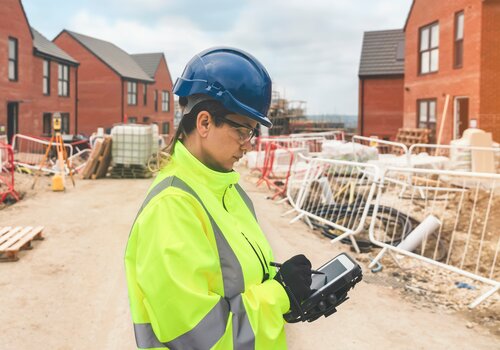The value of EHS software solutions surely is apparent to any construction professional who’s had to search for a coffee-stained training document from two weeks ago due to a workplace injury or an OSHA site visit.
By digitizing their safety programs and establishing a central repository for relevant documentation, construction companies can promote a culture of safety, boost employee engagement and streamline regulatory compliance.
What’s more, vendors of environmental, safety and health software are working hard to improve their products, leveraging artificial intelligence to make jobsites safer, according to Taylor Thorn, senior director for product at vendor KPA.
HOW EHS SOFTWARE WORKS
EHS software already can analyze large volumes of construction data and generate recommendations to improve safety. In a simple example, the software will detect an uptick in injuries or near misses associated with specific types of equipment such as forklifts and suggest additional training for those workers, Thorn said.
Through customizable dashboards and data analytics, contractors can recognize and address safety issues as soon as they emerge, but the possibilities don’t end there. With many contractors using cameras to monitor activity at jobsites, software vendors are developing AI features that will analyze video feeds and spot potential safety hazards in real time, Thorn said.
In the near future, EHS software will be able to detect when equipment, construction materials and other objects are placed in dangerous locations or stored improperly on jobsites. The software also will recognize when workers aren’t wearing the right personal protective equipment or are wearing it incorrectly, Thorn said.
“Savvy clients and prospects are asking us about our plans with AI, so it’s become something we need to have from a business standpoint to remain competitive,” he said. “It’s going to take time to develop, but contractors are starting to see the real safety benefits that AI could provide, so it’s front and center in our discussions.”
It gives you confidence that you’re reporting accurate data about what’s happening at your jobsites, and that’s invaluable.
Christi Fabela
Director of Product Optimization, AlignOps
BENEFITS OF USING EHS SOFTWARE
Right now, one of the principal benefits of EHS software is the automation of OSHA 300, 300A and 301 logs for work-related injuries and illnesses, according to Christi Fabela, director of product optimization for vendor AlignOps. The software ensures accurate recordkeeping so companies can avoid penalties, and it eliminates the need to hunt down documents from incidents that occurred several months ago, streamlining the annual reporting process.
EHS software platforms can be accessed by workers in the field on their smartphones and tablets, so they can fill out incident reports immediately, while the details are fresh in their mind, Fabela said. Leading software programs provide a user-friendly interface and documentation in multiple languages, making them accessible to the entire workforce.
In years past, Fabela typically would tape paper log sheets to the walls of construction trailers so supervisors and safety professionals could document incidents and near misses. But with ESH software, it’s no longer necessary to collect and store handwritten notes throughout the year. And by digitizing all their safety forms, contractors can be certain that they’re meeting the OSHA requirement to store incident logs for five years.
“With EHS software, that information is collected in the moment or shortly thereafter and is stored in a way that the administrator doesn’t have to worry about it,” Fabela said. “Just press a few buttons, and the software produces a spreadsheet that you can upload to OSHA’s website, so the time savings are incredible. It gives you confidence that you’re reporting accurate data about what’s happening at your jobsites, and that’s invaluable.”
DATA COLLECTED
EHS software platforms automatically collect documents related to reportable incidents, toolbox talks, inspections, audits, job-safety analyses, employee certifications, environmental monitoring and the handling of hazardous materials, placing all that data at the fingertips of safety professionals and supervisors.
Popular software programs provide templates for commonly used safety documents, and companies can customize them to their specific practices and projects. Since EHS software automates data collection, improves incident tracking and simplifies reporting, it’s a key factor in helping contractors mitigate their risks, avoid fines and create safer jobsites.
Employees have ready access to safety and training documents as well as OSHA guidelines and stored emergency protocols, helping contractors to comply with OSHA requirements surrounding emergency preparedness.
EHS software tracks and verifies employees’ safety training and certifications and automatically sends them reminders when it’s time for refresher courses. The platforms help companies to ensure that their safety procedures are in line with local, state and federal regulations. They also monitor changes in regulatory requirements, update safety protocols accordingly and generate automated reminders for inspections, training and audits.
When safety issues are detected during inspections, EHS software will recommend corrective actions, assign those tasks to the correct parties and document that those actions have been taken. Contractors can access standardized checklists from OSHA and other regulatory bodies to streamline inspections and automatically generate reports that include photos and comments collected during inspections.
Using the mobile app, workers and supervisors can take pictures of injuries and potential job hazards and attach them to incident reports. Since the photos are time- and location-stamped, reports are accurate and verifiable, which aids in root-cause analysis and may bolster the company’s position if liability issues arise.
“Pictures and that metadata help to paint the whole picture,” Fabela said. “EHS software saves time in the field and improves the accuracy of reports because of the mobile access and real-time data collection. You just open the app on your phone and document the incident instead of waiting until the end of the day to fill out a piece of paper.”
Photo credit: NOSNIBOR137/BIGSTOCKPHOTO.COM












